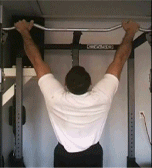Bodyweight exercise

Bodyweight exercises (also called bodyweight workouts) are strength training exercises that use an individual's own weight to provide resistance against gravity.[1] Bodyweight exercises can enhance a range of biomotor abilities including strength, power, endurance, speed, flexibility, coordination and balance.[2] Such strength training has become more popular among recreational and professional athletes.[2] Bodyweight training uses simple abilities like pushing, pulling, squatting, bending, twisting and balancing.[2] Movements such as the push-up, the pull-up, and the sit-up are among the most common bodyweight exercises.[3]
Advantages

While some exercises may require equipment, most bodyweight exercises require none. For exercises requiring equipment, common household items (such as a bath towel for towel curls) are often sufficient, or substitutes may be improvised (for example, using a horizontal tree branch to perform pull-ups). As such, bodyweight exercises are convenient while traveling or on vacation, when access to a gym or specialized equipment may not be available.[5] Another advantage of bodyweight training is that it entails no cost.[1]
Disadvantages
As bodyweight exercises use an individual's own weight to provide movement resistance, the weight being lifted is never greater than one's own body weight, and this can limit new muscle growth. Other downsides are that bodyweight training may be daunting to novices.
Bodyweight exercise for older adults
Some bodyweight exercises have been shown to benefit not just the young, but elderly participants as well.[6] Older people doing bodyweight exercises benefit through gains in muscle mass, in mobility, in bone density, as well as in reduced depression and improved sleep habits.[7][8] It is also believed that bodyweight training may help diminish or even prevent cognitive decline as people age.[5] In addition, the higher risk of falls seen in elderly people may be mitigated by bodyweight training. Exercises focusing on the legs and abdomen such as squats, lunges, and step ups are recommended to increase leg and core strength, in doing so, reduce the risk of falling.[9] Bodyweight exercises provide multi-directional movement that mimics daily activities, and as such can be preferable to using weight machines.[9]
See also
- Asanas
- Calisthenics
- Circuit training
- General fitness training
- High-intensity interval training
- List of weight training exercises
- Physical fitness
- Plyometrics
- Power training
- Resistance training
- Street workout
- Stretching
- Strength training
- Supercompensation
- Suspension training
- Unilateral training
- Weight training
- Yoga
References
- ^ a b Harrison, Jeffrey S (April 2010). "Bodyweight Training: A Return To Basics". Strength and Conditioning Journal. 32 (2): 52–55. doi:10.1519/ssc.0b013e3181d5575c. S2CID 72562058.
- ^ a b c Patel, Kesh (2014). The complete guide to bodyweight training. London, United Kingdom: Bloomsbury Publishing PLC. ISBN 9781472903129.
- ^ Davies, Daniel (2021-04-21). 28 Bodyweight Exercises that Build Serious Muscle. Men's Health. Retrieved 2021-06-10.
- ^ Stryker, Krista, 'Squats for a strong lower body' in The 12-Minute Athlete, New York: Tiller Press, 2020, p.43
- ^ a b "Resistance training – health benefits". Better Health Channel. Retrieved 2016-10-25.
- ^ Yamauchi, Junichiro; Nakayama, Satoshi; Ishii, Naokata (17 August 2009). "Effects of bodyweight-based exercise training on muscle functions of leg multi-joint movement in elderly individuals". Geriatrics & Gerontology International. 9 (3): 262–269. doi:10.1111/j.1447-0594.2009.00530.x. ISSN 1444-1586. PMID 19702936. S2CID 23315560.
- ^ Fujita, Eiji; Takeshima, Nobuo; Kato, Yoshiji; Koizumi, Daisuke; Narita, Makoto; Nakamoto, Hiroki; Rogers, Michael E. (2016-01-01). "Effects of Body-weight Squat Training on Muscular Size, Strength and Balance Ability in Physically Frail Older Adults". International Journal of Sport and Health Science. 14: 21–30. doi:10.5432/ijshs.201504.
- ^ Seguin, Rebecca; Epping, Jacqueline; Buchner, David; Bloch, Rina; Nelson, Miriam (2002). "Growing stronger: Strength training for older adults" (PDF). Tufts University. Archived from the original (PDF) on 2017-01-20. Retrieved 2016-10-25.
- ^ a b "Physical activity for older adults". Nutrition Australia. Archived from the original on 2019-07-19. Retrieved 2016-10-25.